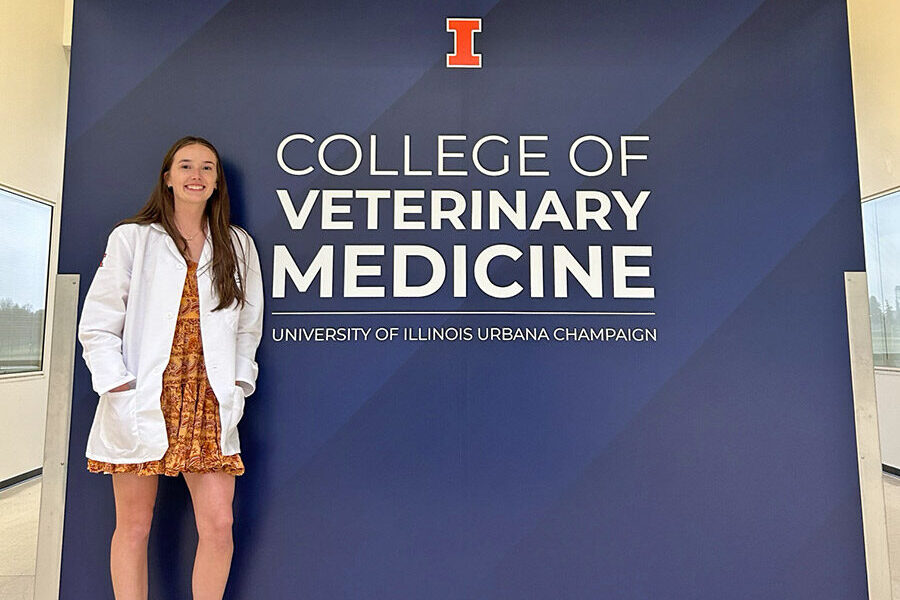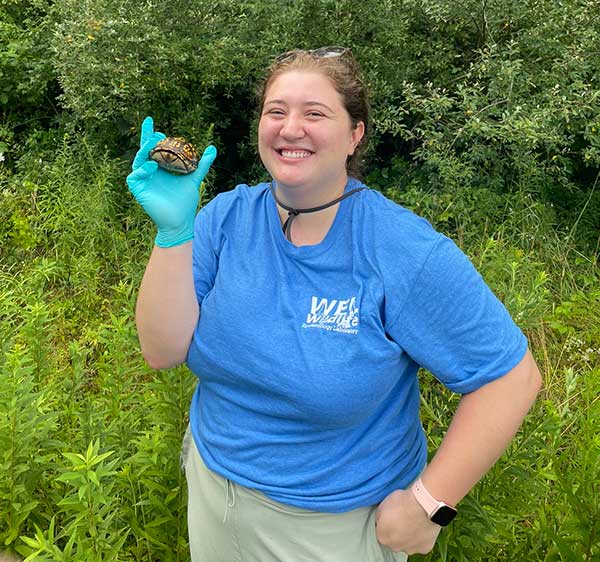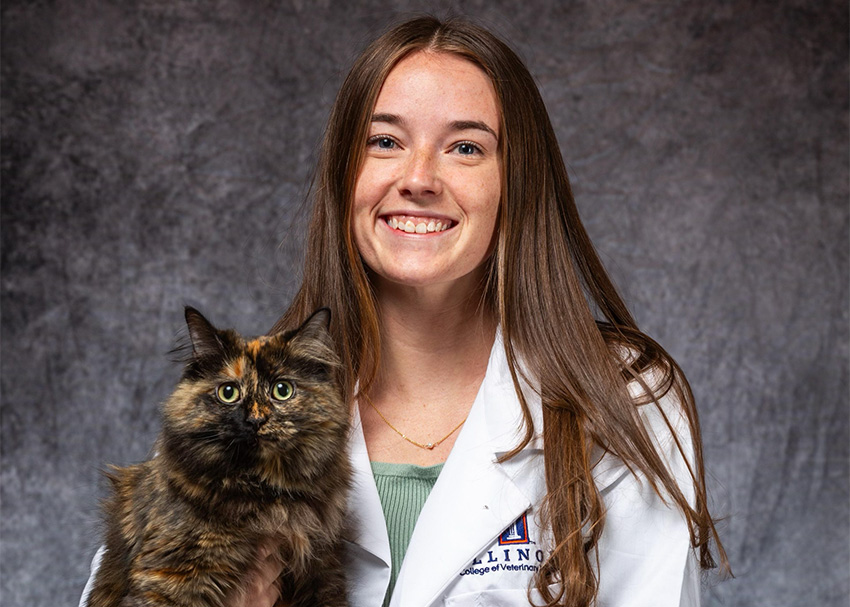‘an incredible team of … veterinarians’
In the spring of 2017 I attended my second Gordon Research Conference on Chemical and Biological Terrorism Defense in California.
Toward the beginning of the meeting, I made my way to dinner, where a co-attendee asked if he could join me at my table, and we began chatting. As it turned out, we were the only individuals at the meeting from the veterinary field, he being retired and I being a student.
Veterinary Connection
As dinner progressed, I learned that although he started as a veterinarian from Kansas, he then went on to obtain a PhD and pursue an Army career that took him around the world. In addition to numerous other notable positions, he also served as the Commander of the United States Army Medical Research Institute of Infectious Diseases (USAMRIID).
At that time in my education, I had certainly heard of places like USAMRIID, but I was more interested in pursuing a career in academia. But in the coming years after that initial conversation, I began speaking with veterinarians from across a wide spectrum of US government agencies, and I finally found the path that fit precisely with not only my scientific interests in veterinary medicine and infectious diseases, but also my personal goals to have a career conducting research of impact and integrity. Consequently, USAMRIID was always high on my list of institutions to visit.
Biosafety Level 4
USAMRIID has been the US Army’s premier research institution for countermeasures against biological warfare since 1969, and is the only laboratory through the US Department of Defense that operates a Biosafety Level 4 facility with positive pressure suits. USAMRIID gained popular notoriety in the 1990s after publication of Richard Preston’s book “The Hot Zone,” narrating incidents involving the Ebola and Marburg hemorrhagic fever viruses, with many scenes at USAMRIID. In addition to developing countermeasures against Ebola and Marburg, USAMRIID has also led research into diseases and pathogens including Anthrax (Bacillus anthracis), Botulism (Clostridium botulinum), the Plague (Yersinia pestis), and Hantavirus.
![[BSL4 lab procedure]](https://vetmed.illinois.edu/wp-content/uploads/2021/04/usamriid.jpg)
Recently, a massive state-of-the-art 835,000-sq-ft facility with multiple high-containment laboratories was built in order to continue the outstanding advancement in infectious disease research. And interestingly, throughout USAMRIID’s history, four USAMRIID Commanders have been veterinarians, and USAMRIID currently employs a large number of both military and civilian veterinarians and veterinary technicians.
Arduous Acceptance Process
Because of my interest in veterinary medicine and infectious disease research in a government institution and my developing interest in laboratory animal medicine, USAMRIID was a perfect fit for an off-campus rotation during my senior clinical year. However, getting into USAMRIID is not an easy task.
The process started almost a year in advance, and included a background investigation and fingerprinting for security clearance, proof of a negative tuberculosis test within 6 months of starting, proof of various vaccination histories or antibody titers, and numerous extensive online training modules for various laboratory animal medicine topics and other basic security training modules (as well as having the rotation approved through campus).
After all of that, the time had finally come in November 2019 for me to visit and study at USAMRIID. You know you are at a phenomenal externship where you leave every day more inspired and excited than the day before for your future in veterinary medicine. Words cannot express how fortunate I felt every day to work with and learn from such an incredible team of brilliant, admirable, and compassionate veterinarians.
Like many institutions, USAMRIID and the US Army overall holds a residency program for lab animal medicine. However, unlike many institutions, the US Army lab animal medicine residency is open only to individuals in the US Army Veterinary Corps. And to set themselves apart, the US Army residency has been uniquely designed to be intensive and rigorous with high standards for academic merit, which has resulted in their residents having consistently the highest pass rate of all of the lab animal medicine (and pathology) residency programs.
What I Learned
Given USAMRIID has restricted access with extensive security,* no photos were allowed of the building or within the research facilities. During my externship, I underwent extensive training in fundamental laboratory safety and biosafety protocols, as well as procedures for working in animal facilities. I practiced core skills in handling and restraint, injection administration, and venipuncture in various small animals (mice, rats, guinea pigs, hamsters, rabbits) and non-human primates (Rhesus and Cynomolgus macaques, African green monkeys, marmosets) that are used in various aspects of infectious disease research.
I learned what goes into caring for a large number of research animals, how medical concerns are addressed, and special considerations for animal husbandry, behavior, and environmental enrichment. I learned about the infrastructure of USAMRIID with specific emphasis on containment laboratories, how air is handled on a massive scale, and measures that are put into place in order to ensure containment when working with dangerous pathogens.
I also learned how research is conducted in a BSL-4 facility, and experienced the challenge of performing even basic tasks in a positive pressure suit firsthand in the BSL-4 training lab.
Outside the Lab
Even though there was never a dull moment while I was at USAMRIID, the area of Frederick, Md., is beautifully positioned for lots of other activities during off hours. I had a lovely time hiking along the Appalachian Trail (a whopping 0.3% of the total distance) at Harper’s Ferry, visiting Washington, D.C., and studying for the NAVLE in the main reading hall of the Library of Congress, and plenty of exploring and visiting various Civil War battlefields and local museums.
Overall, my experience at USAMRIID was wonderfully valuable and an exceptional learning opportunity. If other students are interested in a career in lab animal medicine, infectious diseases, work in the US government, or especially the US Army Veterinary Corps, I highly recommend pursuing an externship at USAMRIID. All individuals I had the utmost privilege to work with, including veterinarians, veterinary technicians, and animal caretakers, are tremendously passionate about their work. Their talent and brilliance are beyond impressive, and they are wonderful examples of individuals who place animal welfare to the highest possible standards, all while striving to make significant contributions to the betterment and advancement of medical care for animals in a research setting.
-Robin L. Holland, PhD; DVM Class of 2020
Feature photo of entrance to the main USAMRIID Building: Wikipedia
* Editor’s note: While USAMRIID is a secure facility and employees must have security clearances to work with biological select agents, the research program is open and unclassified. Scientists publish their work in peer-reviewed journals and present at national and international conferences.

![[entrance to US Army Medical Research Institute of Infectious Disease]](https://vetmed.illinois.edu/wp-content/uploads/2021/04/USAMRIID3.jpg)


